Study on Functional Zoning Method of National Park Based on MCDA: The Case of the Proposed “Ailaoshan-Wuliangshan” National Park
Abstract
1. Introduction
2. Materials and Methods
2.1. Study Area
2.2. Data Sources and Processing
2.3. Methods
2.3.1. Landscape Unit Delineation
2.3.2. Spatial Multi-Criteria Analysis
2.3.3. Spatial Multi-Target Units Allocation
3. Results and Analysis
3.1. Characterization of Landscape Units
3.2. Distribution Characteristics of Different Suitability Values
3.3. Zoning Assessment
4. Discussion
4.1. Scientific and Innovative
4.2. Limitations and Future Research
5. Conclusions
Author Contributions
Funding
Institutional Review Board Statement
Informed Consent Statement
Data Availability Statement
Acknowledgments
Conflicts of Interest
References
- Ma, B.; Zeng, W.; Xie, Y.; Wang, Z.; Hu, G.; Li, Q.; Cao, R.; Zhuo, Y.; Zhang, T. Boundary delineation and grading functional zoning of Sanjiangyuan National Park based on biodiversity importance evaluations. Sci. Total Environ. 2022, 825, 154068. [Google Scholar] [CrossRef]
- Tang, X.; Jiang, Y.; Yang, R.; Zhao, Z.; Ouyang, Z.; Tian, Y.; Xu, W.; Chen, S.; Ma, S.; Liang, B.; et al. GB/T 39737–2021; Specification for National Park Establishment. Standardization Administration of the People’s Republic of China: Beijing, China, 11 October 2021.
- Wang, Y.; Yang, H.; Qi, D.; Songer, M.; Bai, W.; Zhou, C.; Zhang, J.; Huang, Q. Efficacy and management challenges of the zoning designations of China’s national parks. Biol. Conserv. 2021, 254, 108962. [Google Scholar] [CrossRef]
- National Park Service. General Management Plan, Yosemite [EB/OL]. Available online: https://www.nps.Gov/yose/learn/management/upload/YOSE_104_D1316B_-id338162.pdf (accessed on 8 October 2019).
- Zhao, Z.; Peng, L. The Evolution and Development Trend of National Park Zoning Plan. Landsc. Archit. 2020, 27, 73–80. [Google Scholar] [CrossRef]
- Tongariro National Park Management Plan [EB/OL]. Available online:https://www.doc.govt.nz/about-us/our-policies-and-plans/statutory-plans/statutory-planpublications/national-park-management/tongariro-nationalPark-management-plan/ (accessed on 8 October 2019).
- The History of the Nature Conservation Administration of the Department of Natural Protection: The 50th Anniversary of the Natural Park; The Department of the Department of Natural Protection, First Law Publishing: Nieuw-Zuid-Wales, Australie, 1981; p. 73.
- Liu, C. Analysis on Zoning Control in National Park. J. Nanjing Tech. Univ. 2020, 14–30, 111. [Google Scholar]
- Zhang, Y.; Zhang, Z. Analysis of the construction and operation of national parks and zoning management models in China. Manag. Adm. 2022, 143–148. [Google Scholar] [CrossRef]
- Zhu, Z. A Preliminary Study on the Ecological Classification and Conservation Planning of Nanshan National Park. In Proceedings of the 2019 China Urban Planning Annual Conference, Beijing, China, 27–29 June 2019. [Google Scholar]
- Shen, H.Q. Review of National Park Visitor Experience Indicators A Case Study of ROS, LAC and VERP. Landsc. Archit. 2013, 5, 23. [Google Scholar]
- Coppedge, B.R.; Engle, D.M.; Fuhlendorf, S.D.; Masters, R.E.; Gregory, M.S. Landscape cover type and pattern dynamics in fragmented southern Great Plains grasslands, USA. Landsc. Ecol. 2001, 16, 677–690. [Google Scholar] [CrossRef]
- Mulyana, A.; Moeliono, M.; Minnigh, P.; Indriatmoko, Y.; Limberg, G. Establishing Special Use Zones in National Parks. 2010. Available online: https://www.cifor.org/publications/pdf_files/infobrief/001-Brief.Pdf (accessed on 6 August 2022).
- Fu, M.; Tian, J.; Ren, Y.; Li, J.; Liu, W.; Zhu, Y. Functional zoning and space management of Three-River-Source National Park. J. Geogr. Sci. 2019, 29, 2069–2084. [Google Scholar] [CrossRef]
- Lin, Z.; Tu, W.; Hong, Y.; Huang, J.; Liu, J. Optimal design of functional zoning of nature reserves based multiple spatial characteristics. J. For. Environ. 2019, 39, 248–255. [Google Scholar] [CrossRef]
- Wang, B.; Guan, W.B.; Jian-An, W.U. A Method for Assessing Regional Ecological Security Pattern to Conserve Biodiversity—GAP Analysis. Res. Soil Water Conserv. 2006, 13, 192–196. [Google Scholar]
- Li, F.; Xu, M.; Liu, Q.; Wang, Z.; Xu, W. Ecological restoration zoning for a marine protected area: A case study of Haizhouwan National Marine Park, China. Ocean Coast. Manag. 2014, 98, 158–166. [Google Scholar] [CrossRef]
- Yu, J.; Shen, Y.; Song, X.; Chen, X.; Li, S.; Shen, X. Evaluating the effectiveness of functional zones for black muntjac (Muntiacus crinifrons) protection in Qianjiangyuan National Park pilot site. Biodivers. Sci. 2019, 27, 5–12. [Google Scholar]
- Ma, B.; Zeng, W.; Xie, Y. The functional zoning method for natural parks: A case study of Huangshan Scenic Area. Acta Ecol. Sin. 2019, 39, 8286–8298. [Google Scholar]
- Tian, Q.; Huang, F.; Wang, K.; Wan, D.; Li, J.; Wang, H. Land ecological suitability evaluation of nature reserve: With Wanfo Mountain Nature Reserve in Hunan Province as an example. J. Zhejiang Univ. 2020, 46, 201–208. [Google Scholar]
- Li, J.; Liu, X. Research of the Nature Reserve Zonation Based on the Least-cost Distance Model. J. Nat. Res. 2006, 21, 217–224. [Google Scholar]
- Geneletti, D.; Duren, I.V. Protected area zoning for conservation and use: A combination of spatial multicriteria and multiobjective evaluation. Landsc. Urban Plan. 2008, 85, 97–110. [Google Scholar] [CrossRef]
- Nandy’, S.; Singh, C.; Das, K.K.; Kingma, N.C.; Kushwaha, S.P.S. Environmental vulnerability assessment of eco-development zone of Great Himalayan National Park, Himachal Pradesh, India. Ecol. Indic. 2015, 57, 182–195. [Google Scholar] [CrossRef]
- Wang, Z.; Li, Y.; Hua, S.; Zhou, J.; Liu, W.; Liao, S. Functional Zoning of Potatso National Park by Ecological Protection Weighting. J. Nanjing For. Univ. 2021, 45, 225–231. [Google Scholar]
- Zhang, J.; Wei, W.; Cheng, Y.; Zhao, B. Study on site selection of small and medium-sized city parks based on GIS suitability evaluation. J. Nanjing For. Univ. 2020, 44, 171–178. [Google Scholar]
- Beinat, E.; Nijkamp, P. Land-use management and the path toward sustainability. In Multicriteria Analysis for Land-Use Management; Beinat, E., Nijkamp, P., Eds.; Kluwer Academic Publishers: Dordrecht, The Netherlands, 1998; pp. 1–13. [Google Scholar]
- Esmail, B.A.; Geneletti, D. Multi-criteria decision analysis for nature conservation: A review of 20years of applications. Methods Ecol. Evolut. 2018, 9, 42–53. [Google Scholar] [CrossRef]
- Randal, G.; Joan, E.; Rodolphe, D.; Brian, G.E. An approach to GIS-based multiple criteria decision analysis that integrates exploration and evaluation phases: Case study in a forest-dominated landscape. For. Ecol. Manag. 2010, 260, 2102–2114. [Google Scholar]
- Bereket, T.H.; Fang, Q. Zoning for a multiple-use marine protected area using spatial multi-criteria analysis: The case of the Sheik Seid Marine National Park in Eritrea. Mar. Policy 2016, 63, 135–143. [Google Scholar]
- Liu, G.H.; Liu, J.W.; Zhu, Y.H. Land-unit Based Flow Network Model in Small Catchment with GIS Support. Prog. Geogr. 2011, 21, 139–145. [Google Scholar]
- Niekerk, A.V. A comparison of land unit delineation techniques for land evaluation in the Western Cape, South Africa. Land Use Policy 2010, 27, 937–945. [Google Scholar] [CrossRef]
- Geneletti, D. A GIS-based decision support system to identify nature conservation priorities in an alpine valley. Land Use Policy 2004, 21, 149–160. [Google Scholar] [CrossRef]
- Rincón, V.; Velázquez, J.; Gutiérrez, J.; Sánchez, B.; Hernando, A.; García-Abril, A.; Santamaría, T.; Sánchez-Mata, D. Evaluating European Conservation Areas and Proposal of New Zones of Conservation under the Habitats Directive. Application to Spanish Territories. Sustainability 2019, 11, 398. [Google Scholar] [CrossRef]
- Boulad, N.; Hamidan, N. The use of a GIS-based multi-criteria evaluation technique for the development of a zoning plan for a seasonally variable Ramsar wetland site in Syria: Sabkhat Al-Jabboul. Wetl. Ecol. Manag. 2018, 26, 253–264. [Google Scholar] [CrossRef]
- Cao, M.; Ma, Y.; Sun, Z.; Hu, H.; Zhu, H.; Sheng, C.; Li, Z.; Guo, H.; An, L.; Si, Z.; et al. LY/T 2242-2014; Technical Regulation for Biodiversity Impact Assessment of Construction Project in Nature Reserve. The State Forestry Administration of the People’s Republic of China: Beijing, China, 21 August 2014.
- Tang, X.; Jiang, Y.; Sun, H.; Chen, Y.; Peng, R.; Wu, C.; Cui, G.; Liang, B.; Liu, Z.; Chen, J.; et al. GB/T 39736-2020; Technical Regulations for the National Park Master Plan. Standardization Administration of the People’s Republic of China: Beijing, China, 22 December 2020.
- Arthur, D.; Vassilvitskii, S. K-Means++: The Advantages of Careful Seeding. In Proceedings of the Eighteenth Annual ACM-SIAM Symposium on Discrete Algorithms, SODA 2007, New Orleans, LA, USA, 7–9 January 2007. [Google Scholar]
- Eastman, J.R.; Jiang, H.; Toledano, J. Multi-Criteria and Multi-Objective Decision Making for Land Allocation Using GIS; Springer: Dordrecht, The Netherlands, 1998. [Google Scholar]
- Zhang, Z.; Sherman, R.; Yang, Z.; Wu, R.; Wang, W.; Yin, M.; Yang, G.; Ou, X. Integrating a participatory process with a GIS-based multi-criteria decision analysis for protected area zoning in China. J. Nat. Conserv. 2013, 21, 225–240. [Google Scholar] [CrossRef]
- Zhou, K.; Liu, H.; Fan, J.; Yu., H. Environmental stress intensity of human activities and its spatial effects in the Qinghai-Tibet Plateau national park cluster: A case study in Sanjiangyuan region. Acta Ecol. Sin. 2021, 41, 268–279. [Google Scholar]
- Hidle, K. How National Parks Change a Rural Municipality’s Development Strategies—The Skjåk Case, Norway. J. Rural Stud. 2019, 72, 174–185. [Google Scholar] [CrossRef]
- Eugenio, C.; Marilena, L.; Francisco, N. Protected Natural Spaces, Agrarian Specialization and the Survival of Rural Territories: The Cases of Sierra Nevada (Spain) and Alta Murgia (Italy). Land 2022, 11, 1166. [Google Scholar]
- Moyle Brent, D. Managing outdoor recreation: Case studies in the national parks. Ann. Tour. Res. A Soc. Sci. J. 2013, 41, 253–254. [Google Scholar]
- Zhong, L. Eco-friendly facilities: An important guarantee for the green development of national parks. Tour. Trib. 2018, 33, 8–9. [Google Scholar]
- Jianghui, G.E.; Dexia, Z.A.N.G. Research on the Construction of Chinese National Park System Based on Sustainable Development Theory. J. Landsc. Res. 2015, 7, 13–16. [Google Scholar] [CrossRef]
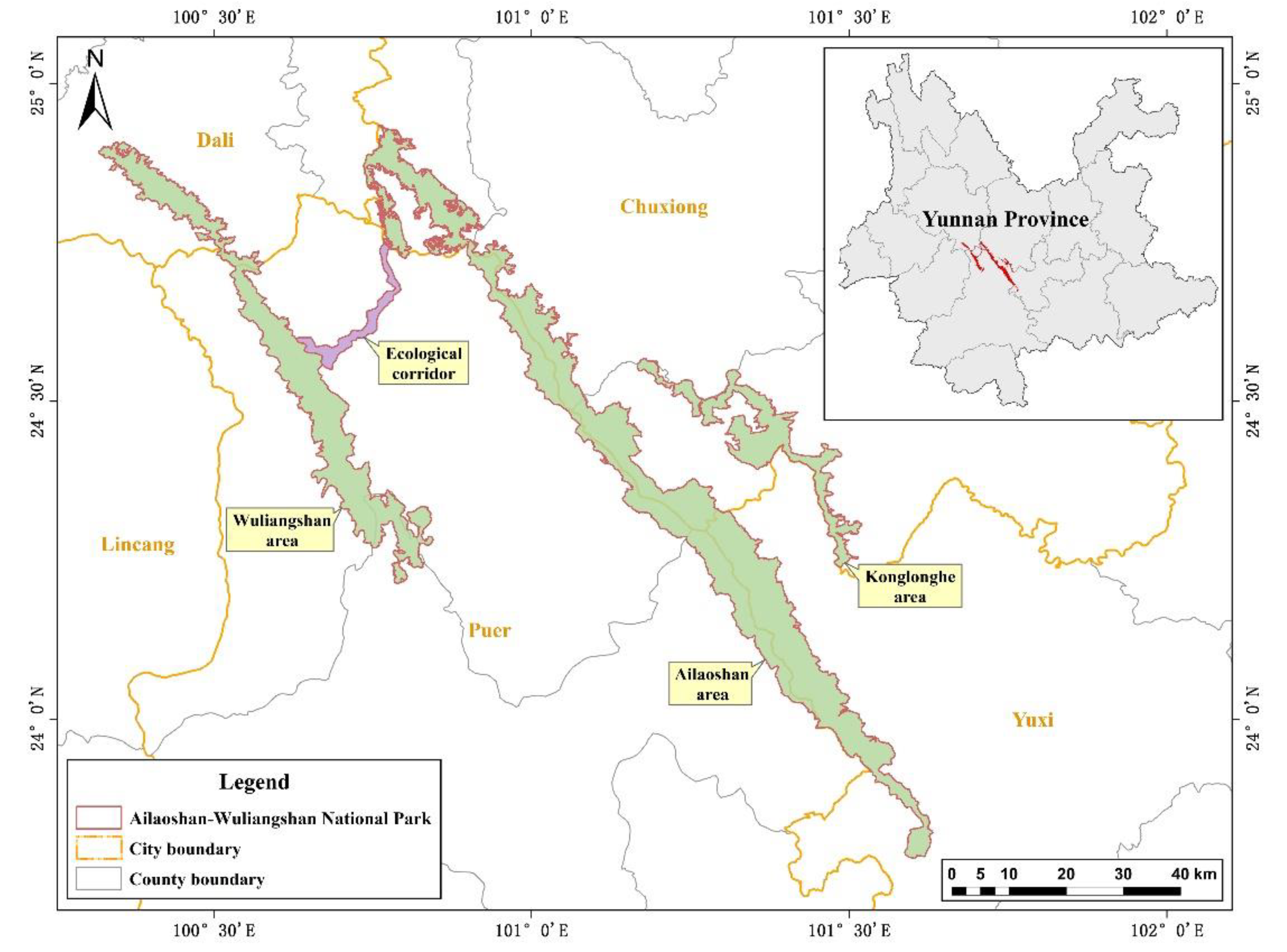
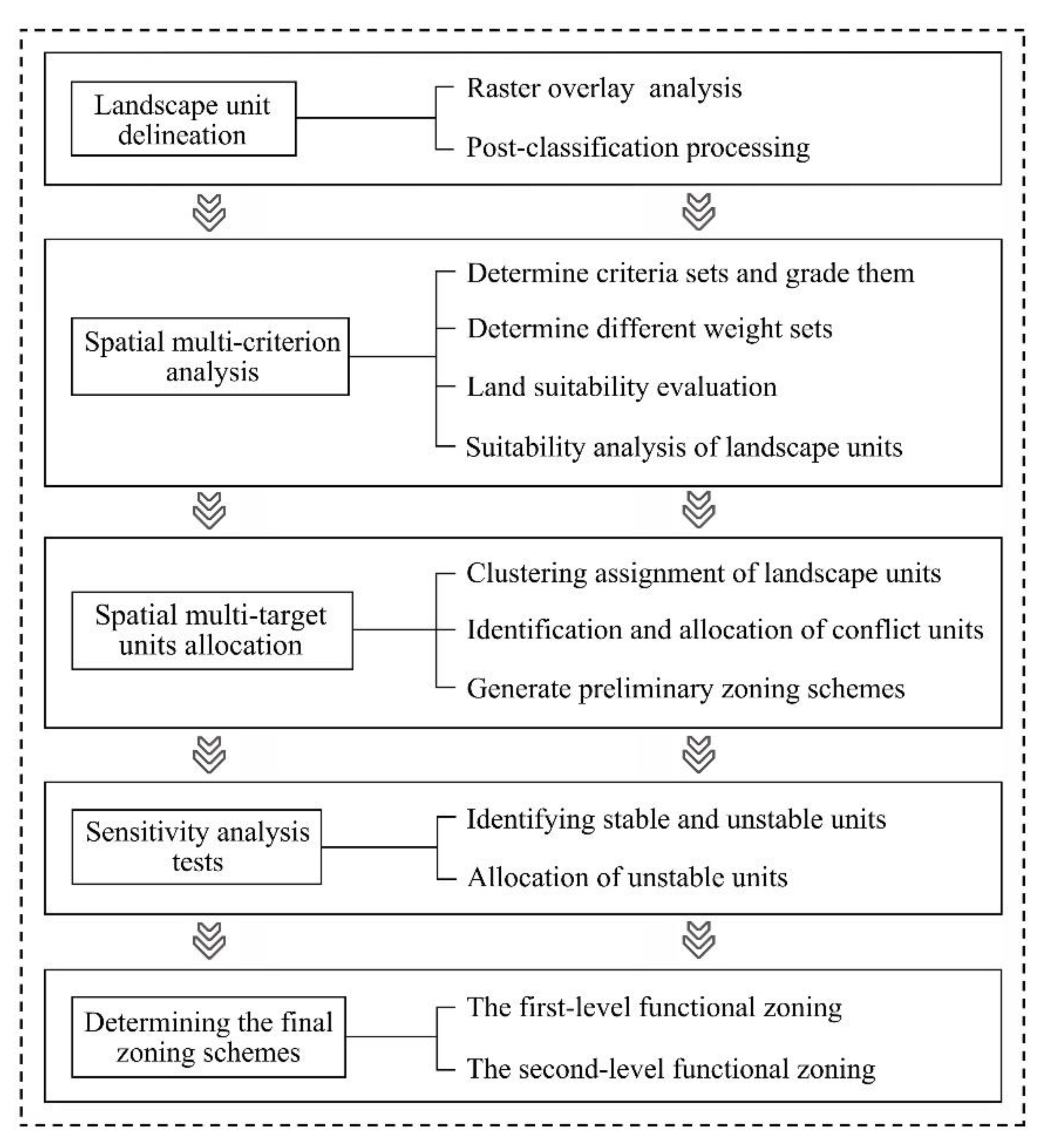

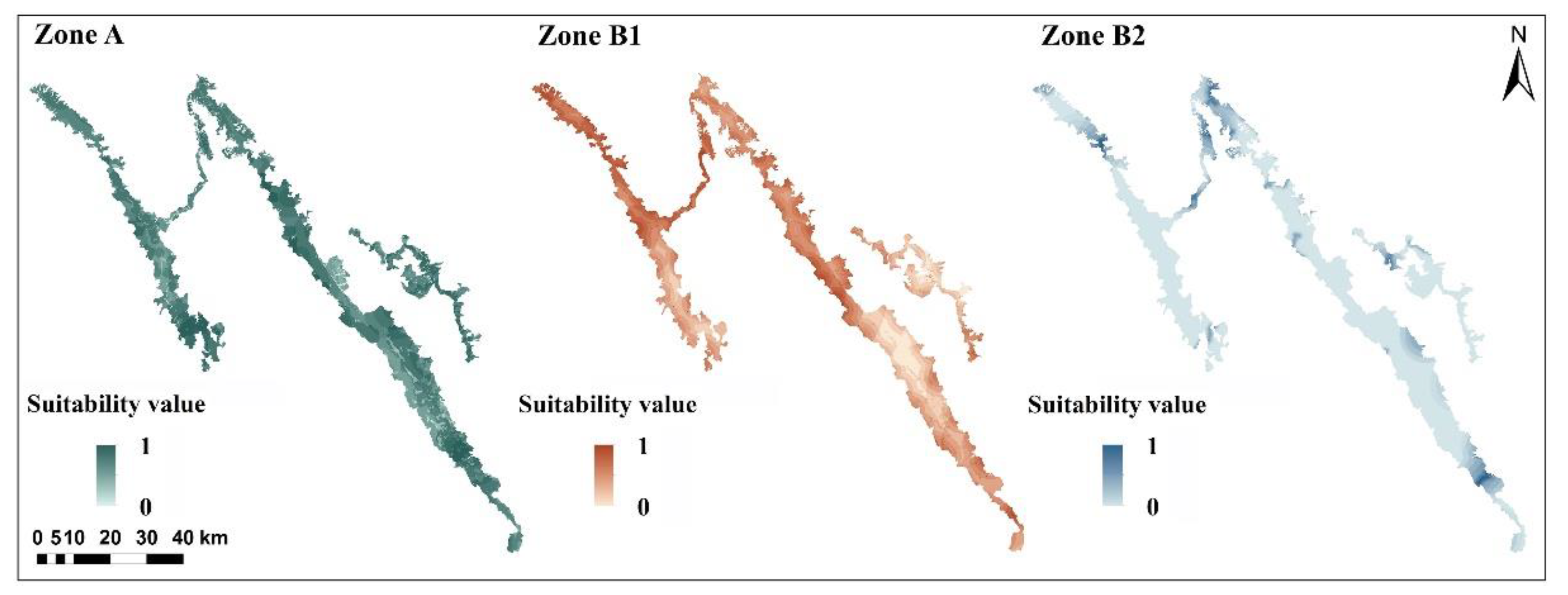
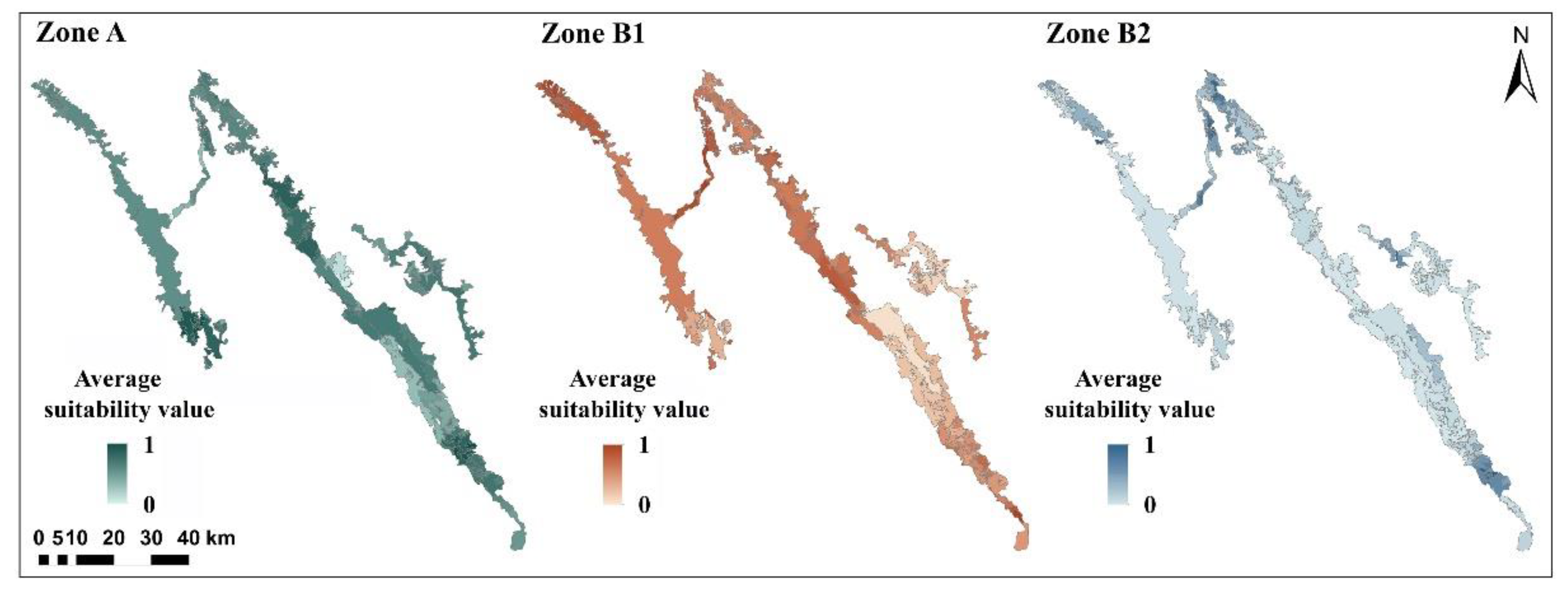
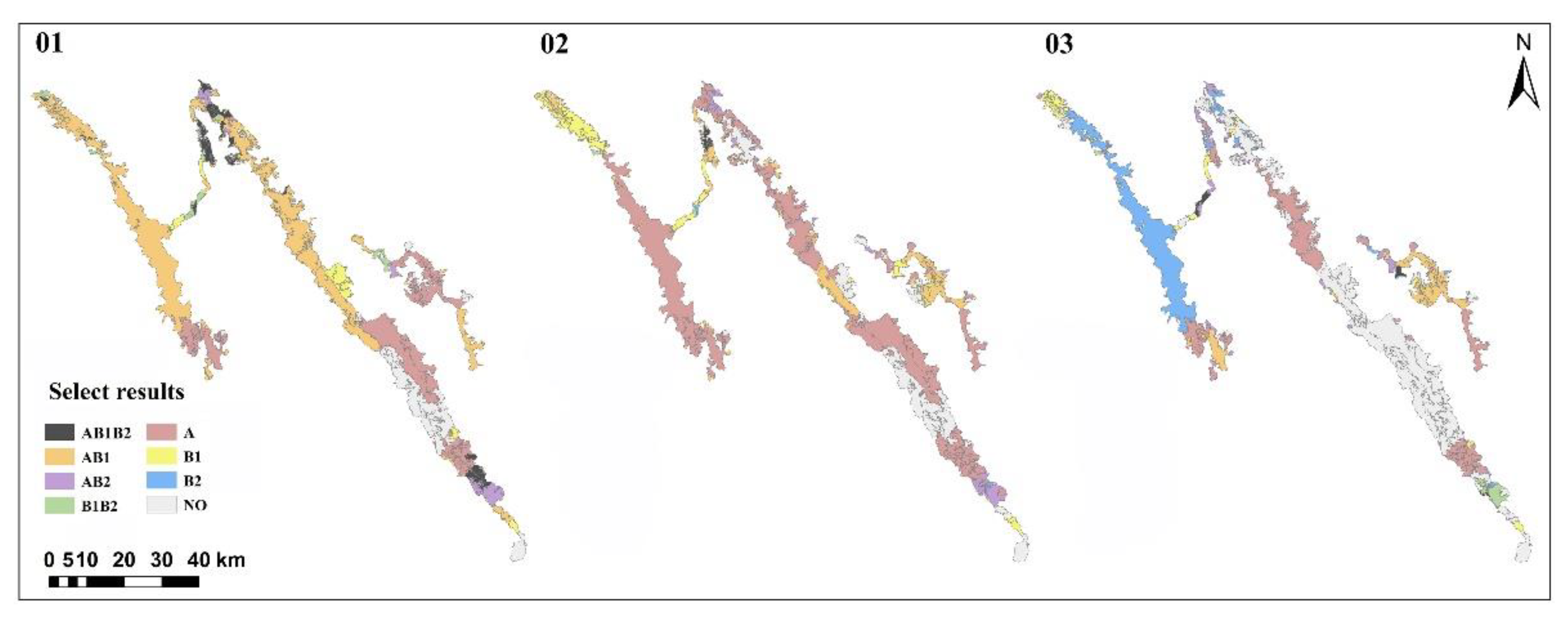
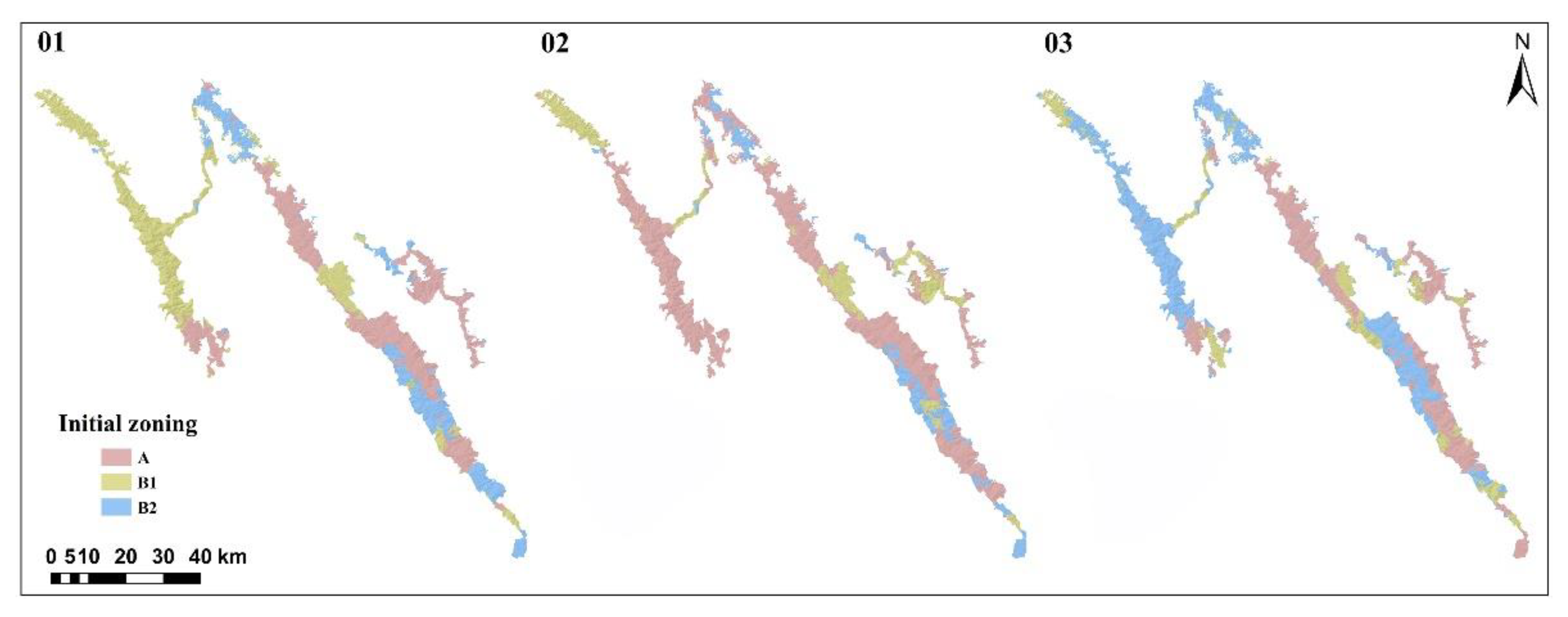
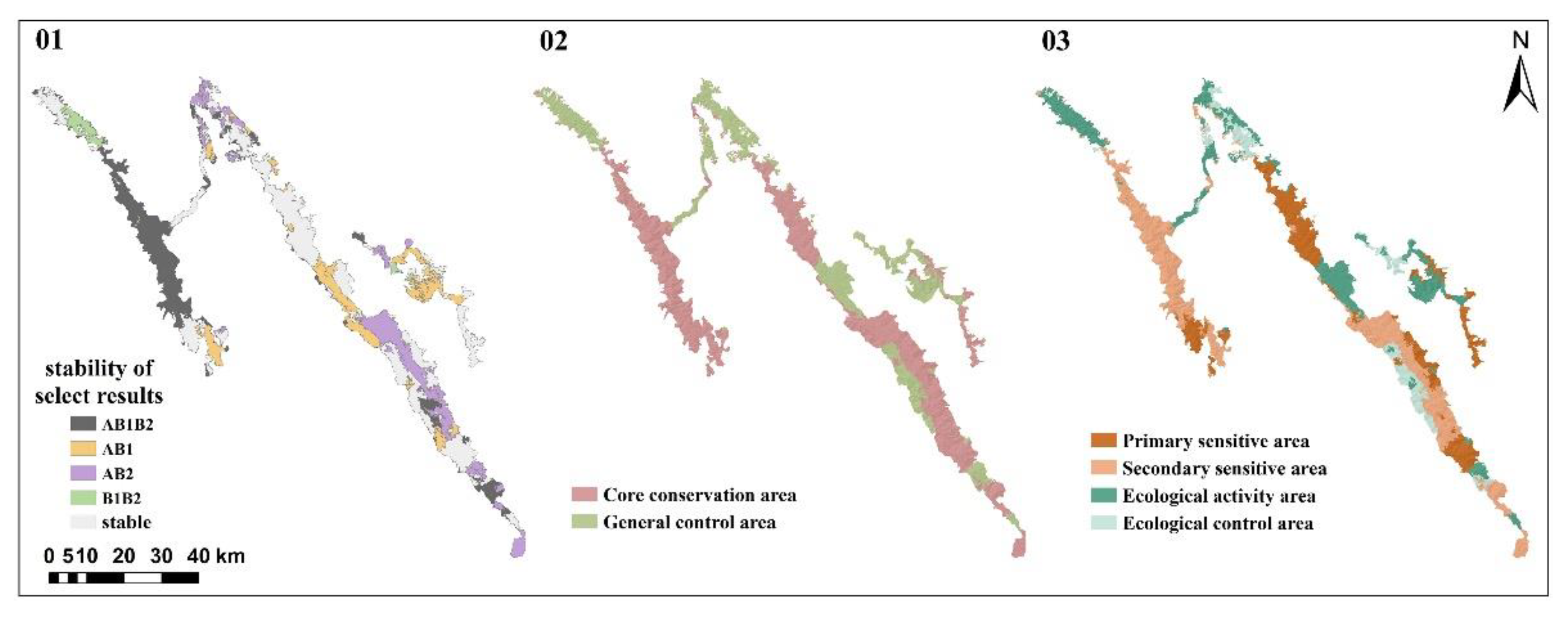
| Data Type | Classification | Code | Data Types | Classification | Code |
|---|---|---|---|---|---|
| Altitude | 537–1312 m | 1 | Slope | 3–10% | 1 |
| 1312–1912 m | 2 | 10–25% | 2 | ||
| 1912–2337 m | 3 | 25–50% | 3 | ||
| 2337–2628 m | 4 | 50–100% | 4 | ||
| 2628–3348 m | 5 | Land use type | Arboreal forest | 01 | |
| Soil | LVg | 01 | Construction land | 02 | |
| LVk | 02 | Cultivated land | 03 | ||
| LVj | 03 | Temporary land use | 04 | ||
| PZg | 04 | Immature forest land | 05 | ||
| PDd | 05 | Water area | 06 | ||
| CMd | 06 | Shrub land | 07 | ||
| GLe | 07 | Barren hills and wasteland | 08 | ||
| CMx | 08 | Unused land | 09 | ||
| CMc | 09 | Harvested land | 10 | ||
| LVh | 10 | Open woodland | 11 | ||
| GLu | 11 |
| Criterion Sets | Zone A | Zone B1 | Zone B2 | ||||||
|---|---|---|---|---|---|---|---|---|---|
| VT | HEA | RWS | ATA | VAL | AL | TSF | RF | R | |
| weight sets 1 | 0.4 | 0.4 | 0.2 | 0.4 | 0.4 | 0.2 | 0.4 | 0.4 | 0.2 |
| weight sets 2 | 0.333 | 0.333 | 0.333 | 0.333 | 0.333 | 0.333 | 0.333 | 0.333 | 0.333 |
| weight sets 3 | 0.275 | 0.275 | 0.450 | 0.275 | 0.275 | 0.450 | 0.275 | 0.275 | 0.450 |
Publisher’s Note: MDPI stays neutral with regard to jurisdictional claims in published maps and institutional affiliations. |
© 2022 by the authors. Licensee MDPI, Basel, Switzerland. This article is an open access article distributed under the terms and conditions of the Creative Commons Attribution (CC BY) license (https://creativecommons.org/licenses/by/4.0/).
Share and Cite
Liu, J.; Huang, X.; Guo, H.; Zhang, Z.; Li, X.; Ge, M. Study on Functional Zoning Method of National Park Based on MCDA: The Case of the Proposed “Ailaoshan-Wuliangshan” National Park. Land 2022, 11, 1882. https://doi.org/10.3390/land11111882
Liu J, Huang X, Guo H, Zhang Z, Li X, Ge M. Study on Functional Zoning Method of National Park Based on MCDA: The Case of the Proposed “Ailaoshan-Wuliangshan” National Park. Land. 2022; 11(11):1882. https://doi.org/10.3390/land11111882
Chicago/Turabian StyleLiu, Junze, Xiaoyuan Huang, Huijun Guo, Zhuoya Zhang, Xiaona Li, and Mengxiao Ge. 2022. "Study on Functional Zoning Method of National Park Based on MCDA: The Case of the Proposed “Ailaoshan-Wuliangshan” National Park" Land 11, no. 11: 1882. https://doi.org/10.3390/land11111882
APA StyleLiu, J., Huang, X., Guo, H., Zhang, Z., Li, X., & Ge, M. (2022). Study on Functional Zoning Method of National Park Based on MCDA: The Case of the Proposed “Ailaoshan-Wuliangshan” National Park. Land, 11(11), 1882. https://doi.org/10.3390/land11111882










